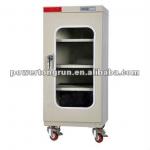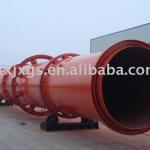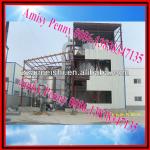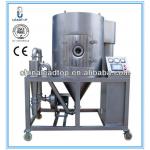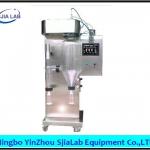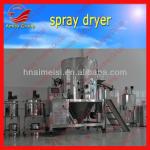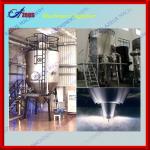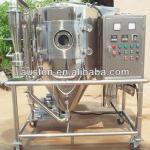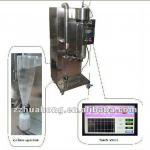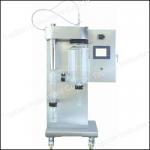Lab spray dryer / Spray dryer for R&D
| Condition:New | Type:Spray Drying Equipment | Place of Origin:Jiangsu China (Mainland) | Brand Name:Lemar |
| Model Number:LPG | Warranty:1 year | After-sales Service Provided:Engineers available to service machinery overseas | Control system:Touch screen |
| Material:SUS304 | Heating source:Electricity | Spray type:Centrifugal type |
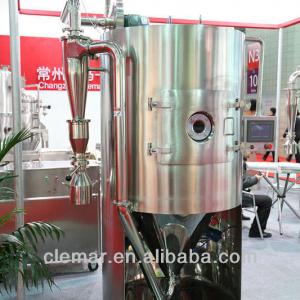
LPG-5 Spray Dryer is widely used for doing experiment and new product R&D. Its operating is convenient and easy to clean.
Following is the parameters of the LPG-5 Spray dryer.
1. Inlet air temperature: 160 °C ~220 °C
2. Outlet air temperature: 80 °C ~90 °C
3. Water evaporation: 3kg~5kg/h
4. Centrifugal atomizer: Pneumatic type
5. Elecctrical heater: 12Kw
6. Feed pump: Peristaltic pump
7. Control system: Touch screen & PLC
8. Power of fan: 0.75Kw
LPG-10 Spray Dryer (Air sweep type) also is widely used for doing experiment and new product R&D. It is specially suitable for the viscosity materials that easy to stick on the inner wall such as Chinese herbal medicine extract, flavoring, etc. For common, if the material stick on the wall ,it is hard to clean it during the drying process. But this spray dryer has a special air sweep system, it can move around the inner wall during the drying process, and sprays high pressure air to the inner wall, the material that stick on the inner wall can be cleaned effectively.
The machine also can be equipped a freeze dehumidifier, it will provide dry cool air to the barrel of first stage cyclone, the dry cool air will displace the hot air with moisture, so the powder will not absorb the moisture or lump. and the powder will be coolled to about 30°C, and then collected by the second stage cyclone. Because the powder is cooled, so it can be packed directly.
Following is the parameters of the LPG-10 Spray dryer(Air sweep type).
1. Inlet air temperature: 160 °C ~220 °C
2. Outlet air temperature: 80 °C ~90 °C
3. Water evaporation: 8kg~10kg/h
4. Elecctrical heater: 36Kw
5. Feed pump: Peristaltic pump
6. Control system: Touch screen & PLC
7. Power of blower: 0.37Kw
8. Power of exhaust fan: 0.75Kw
9. Powder collecting system: Two stage cyclone separator
10. Option system: Dehumidifier
Following is the description of spray dryer:
1. Process
Spray dryingis the most widely used industrial process involving particle formation and drying. It is highly suited for the continuous production of dry solids in either powder, granulate or agglomerate form from liquid feedstocks as solutions, emulsions and pumpable suspensions. Therefore, spray drying is an ideal process where the end-product must comply to precise quality standards regarding particle size distribution, residual moisture content, bulk density, and particle shape.
Spray dryinginvolves the atomization of a liquid feedstock into a spray of droplets and contacting the droplets with hot air in a drying chamber. The sprays are produced by either rotary (wheel) or nozzle atomizers. Evaporation of moisture from the droplets and formation of dry particles proceed under controlled temperature and airflow conditions. Powder is discharged continuously from the drying chamber and recovered from the exhaust gases using a cyclone or a bag filter. Operating conditions and dryer design are selected according to the drying characteristics of the product and powder specification.
2. Principles
Every spray dryer consists of feed pump, atomizer, air heater, air disperser, drying chamber, and systems for exhaust air cleaning and powder recovery.
Widely varying drying characteristics and quality requirements of the thousands of products spray dried determine the selection of the atomizer, the most suitable airflow pattern, and the drying chamber design.
3. Atomization
The formation of sprays having the required droplet size distribution is vital to any successful spray dryer operation so that powder specifications can be met.
4. Airflow
The initial contact between spray droplets and drying air controls evaporation rates and product temperatures in the dryer. There are three modes of contact:
4.1 Co-current
Drying air and particles move through the drying chamber in the same direction. Product temperatures on discharge from the dryer are lower than the exhaust air temperature, and hence this is an ideal mode for drying heat sensitive products. When operating with rotary atomizer, the air disperser creates a high degree of air rotation, giving uniform temperatures throughout the drying chamber.
4.2 Counter-current
Drying air and particles move through the drying chamber in opposite directions. This mode is suitable for products which require a degree of heat treatment during drying. The temperature of the powder leaving the dryer is usually higher than the exhaust air temperature.
4.3 Mixed flow
Particle movement through the drying chamber experiences both co-current and counter-current phases. This mode is suitable for heat stable products where coarse powder requirements necessitate the use of nozzle atomizers, spraying upwards into an incoming airflow, or for heat sensitive products where the atomizer sprays droplets downwards towards an integrated fluid bed and the air inlet and outlet are located at the top of the drying chamber.
We can assist you with all your spray drying projects, whether you are conducting R&D spray drying, interested in small-scale spray drying, or full an industrial spray drying production facility. We offer powder engineering solutions and proof of concept through laboratory and pilot-plant testing. We also possess an unmatched scale-up experience and global project execution according to your specifications.

| Packaging Detail:Wooden case |
| Delivery Detail:Within 45 working days after receiving your advanced payment |




